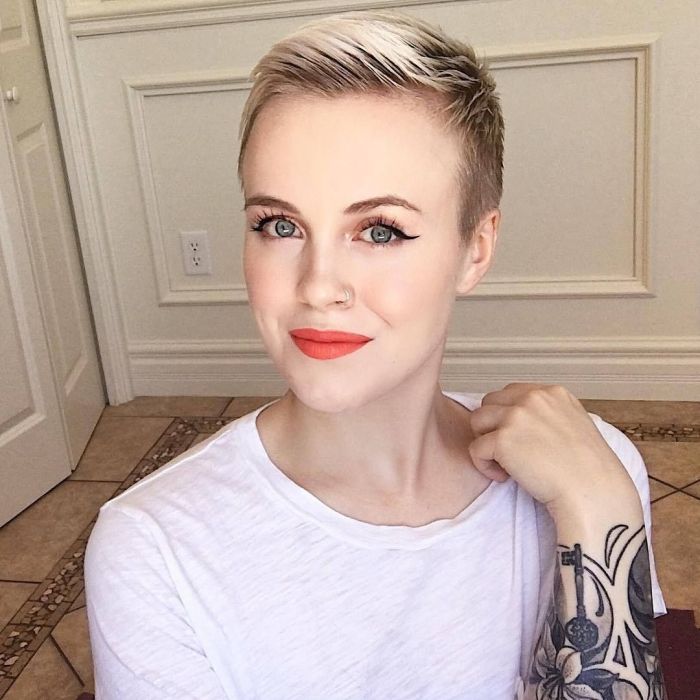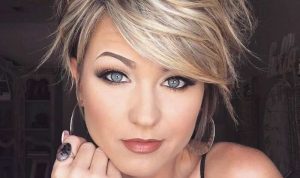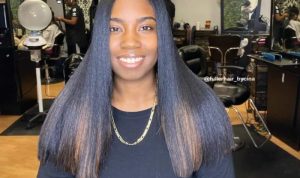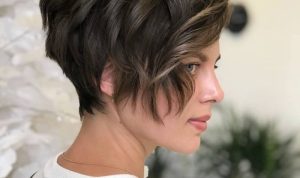Pixie Hairstyles for Fine Hair
Pixie hairstyles for fine hair – Pixie cuts offer a surprisingly versatile and stylish option for those with fine hair. Their short length and adaptable styling options can create the illusion of thicker, fuller hair, while simultaneously showcasing a chic and modern look. This guide explores the various aspects of pixie cuts for fine hair, from choosing the right style to maintaining its health and vibrancy.
Introduction to Pixie Hairstyles for Fine Hair

Source: latest-hairstyles.com
Pixie cuts are incredibly versatile for fine hair, allowing for a range of styles to suit different personalities and preferences. The short length minimizes the appearance of thinness, and strategic layering and texturizing techniques can add significant volume and body. This contrasts sharply with longer hairstyles that can sometimes make fine hair appear even thinner and limp.
The key benefit of a pixie cut for fine hair is its ability to create the illusion of thicker hair. By removing weight and strategically layering the hair, the cut allows each strand to stand out, creating more visual density. This is especially effective when combined with styling techniques that add texture and lift.
Several pixie variations are ideal for fine hair. Layered pixies add movement and dimension, preventing the hair from falling flat. Textured pixies, often achieved through choppy layers and styling products, create a tousled, voluminous look. Long pixies offer a slightly longer length on top, providing more styling versatility and the illusion of more hair.
Choosing the Right Pixie Cut Based on Face Shape
The ideal pixie cut complements your face shape, enhancing your best features. Different pixie variations can subtly alter the perception of facial proportions, creating a more balanced and harmonious look. Hair texture and density also play a significant role in pixie cut selection. For example, very fine, straight hair might benefit from a textured pixie for added volume, while slightly thicker, wavy hair might suit a more sleek, shorter style.
| Face Shape | Suitable Pixie Style | Illustrative Description | Things to Avoid |
|---|---|---|---|
| Round | Layered Pixie with Height | Asymmetrical layers and height on top create length and definition, balancing the roundness. | Blunt, short, and uniform cuts that lack height. |
| Oval | Versatile Pixie Styles | Most pixie styles suit oval faces due to their balanced proportions. | Styles that overly conceal the face’s natural shape. |
| Square | Long Pixie with Side Swept Bangs | Softer layers and side-swept bangs help soften the strong jawline. | Short, blunt cuts that emphasize angular features. |
| Heart | Pixie with Longer Layers in the Front | Longer layers framing the face draw attention away from a wide forehead. | Short, choppy cuts that emphasize the forehead’s width. |
A visual guide, described textually, could illustrate how a pixie with long, side-swept bangs can soften a square face, while a pixie with short, choppy layers can add volume to a round face. Conversely, a sleek, short pixie might accentuate a strong jawline on a square face, while a pixie with height on top could make a long face appear even longer.
Styling Techniques for Fine Hair Pixies
Achieving volume and texture in fine hair pixie cuts requires specific styling techniques and products. The right approach can transform a limp pixie into a stylish and voluminous look. The key is to use products that add texture without weighing the hair down.
Mousses, texturizing sprays, and volumizing powders are excellent choices. Mousses provide lift at the roots, texturizing sprays add grip and separation, and volumizing powders create extra body and texture. Apply mousse to damp hair before blow-drying, focusing on the roots. Use texturizing spray on dry hair to enhance texture and separation. Volumizing powder can be applied to the roots for added lift.
For everyday styling, a quick blow-dry with a round brush can add volume and shape. For formal events, consider using a stronger hold hairspray and potentially some light curling or straightening to achieve a more polished look. A step-by-step guide for an everyday look could include blow-drying with a round brush, using a texturizing spray, and finishing with a light hairspray.
A formal look might involve using a curling iron for soft waves, applying a strong-hold hairspray, and adding a touch of shine serum.
Hair Care Routine for Fine Hair Pixies

Source: latest-hairstyles.com
Maintaining a healthy pixie cut on fine hair requires a dedicated hair care routine. Regular trims and conditioning treatments are crucial to prevent split ends and breakage, keeping the hair looking its best. The right products can also make a significant difference.
- Use a gentle, sulfate-free shampoo and conditioner designed for fine hair. These formulas cleanse without stripping the hair of its natural oils.
- Apply a leave-in conditioner to add moisture and protect against damage.
- Consider using a weekly deep conditioning treatment to hydrate and strengthen the hair.
- Avoid using heavy styling products that can weigh down fine hair.
- Protect your hair from heat styling damage by using heat protectant spray before using hot tools.
Color and Highlights for Fine Hair Pixies, Pixie hairstyles for fine hair
Hair color can significantly enhance a pixie cut on fine hair, adding depth, dimension, and the illusion of thickness. Strategic coloring techniques can create a fuller, more textured appearance.
Balayage, highlights, and ombre are popular choices. Balayage creates a natural-looking sun-kissed effect, adding subtle dimension. Highlights add brightness and lift, making the hair appear thicker. Ombre creates a gradual transition between two shades, adding depth and contrast.
For example, adding subtle highlights around the face can draw attention to the features and create a more youthful appearance. A darker shade at the roots can add depth and volume, while lighter shades on the ends can create a more dimensional look. The choice depends on personal preference and the overall desired look.
Maintaining Your Pixie Cut

Source: stylesweekly.com
Maintaining a pixie cut on fine hair requires regular trims to prevent the hair from looking shaggy or uneven. Managing hair growth between haircuts involves using the right styling products and techniques to keep the cut looking its best. A few essential tools can simplify the process.
Pixie cuts typically require trims every 4-6 weeks to maintain their shape and prevent split ends. Between haircuts, regular styling and the use of appropriate products can help manage hair growth and keep the style looking neat and tidy. A simple checklist might include a small round brush, a hairdryer, a texturizing spray, and some hair clips.
FAQ Summary: Pixie Hairstyles For Fine Hair
How often should I wash my fine hair with a pixie cut?
Washing too frequently can strip natural oils, leading to dryness. Aim for every other day or even every two to three days, depending on your hair and scalp’s needs.
Can I use heat styling tools on my fine hair pixie?
Use heat styling tools sparingly, applying a heat protectant spray beforehand to minimize damage. Air drying is always a gentler option.
Pixie hairstyles are a popular choice for women with fine hair, offering a low-maintenance yet stylish look. The key is finding a cut that adds volume and texture, and for those considering similar options, exploring styles suitable for older women is beneficial. A great resource for finding inspiration is this website dedicated to older womens short hairstyles for thin hair , which can offer ideas adaptable to pixie cuts.
Ultimately, the best pixie cut enhances your features and complements your personal style.
What’s the best way to add volume to my pixie without using heat?
Use volumizing mousse or root lift spray at the roots, then gently tousle your hair while it air dries. Consider using volumizing powder at the roots for extra lift.
How long does a pixie cut typically last before needing a trim?
Generally, pixie cuts require trims every 4-6 weeks to maintain their shape and prevent uneven growth.






